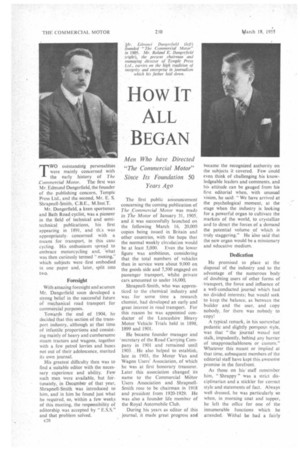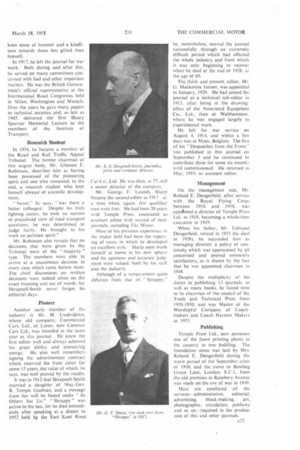How IT
Page 152

Page 155

If you've noticed an error in this article please click here to report it so we can fix it.
ALL BEGAN
Men Who have Directed "The Commercial Motor" Since Its Foundation 50 Years Ago TWO outstanding personalities were mainly concerned with the early history of The .Commercial Motor. The first was Mr. Edmund Dangerfield, the founder of the publishing concern, Temple Press Ltd.. and the second, Mr. E. S. Shrapnell-smith, C.B.E., M.Inst.T.
Mr. Dangerfield, a keen sportsman and Bath Road cyclist, was a pioneer in the field of technical and semi. technical publications, his first appearing in 1891, and th:s was appropriately, concerned with a means for transport, in this case cycling. His enthusiasm spread to embrace motorcycling and, what was then curiously termed " moting," which subjects were -first embodied in one paper and, later, split into two.
Foresight
With amazing foresight and acumen Mr. Dangerfield soon developed a strong belief in the successful future of mechanical road transport for commercial purposes.
Towards the end of 1904, he decided that this section of the transport industry, although at that time of infantile proportions and consisting mainly of heavy and cumbersome steam tractors and wagons, together with a few petrol lorries and buses not out of their adolescence, merited its own journal.
His greatest difficulty then was to find a suitable editor with the necessary experience and ability. Few such men were available, but fo'rtunately, in December of that year, Shrapnell-Smith was introduced to him, and in him he found just what he required, so, within a few weeks of this meeting, the responsibility of editorship was accepted by " E.S.S." and that problem solved.
r20
The first public announcement concerning the coming publication of The Commercial Motor was made in The Motor of January 31, 1905, and it was successfully launched on the following March 16, 20,000 copies being issued in Britain and other countries, with the hope that the normal weekly circulation would be at least 5,000. Even the lower figure was ambitious, considering that the total numbers of vehicles then in service were about 9,000 on the goods side and 7,500 engaged on passenger transport, whilst private cars amounted to under 16,000.
Shrapnell-Smith, who was apprenticed to the chemical industry and was for some time a research chemist, had developed an early and great interest in road transport. For this reason he was appointed conductor of the Lancashire Heavy Motor Vehicle Trials held in 1898, 1899 and 1901.
He became founder manager and 'secretary of the Road Carrying Company in 1901 and remained until 1903. . He also helped to establish, late in 1903, the Motor Van and Wagon Users' Association, of which he was at first honorary treasurer. Later this association changed its name to the Commercial Motor Users Association and ShrapnellSmith rose to be chairman in 1918 and president from 1920-1929. He was also a founder life member of the Royal Automobile Club.
During his years as editor of this journal, it made great progress and became the recognized authority on the subjects it covered. Few could even think of challenging his knowledgeable leaders and comments, and his attitude can be gauged from his first editorial when, with unusual vision, he said: "We have arrived at the psychological moment, at the stage when the industry is looking for a powerful organ to cultivate the markets of the world, to crystallize and to direct the forces of a demand the potential volume of which is truly staggering." He also said that the new organ would be a missionary and educative medium.
Dedication He promised to place at the disposal of the industry and to the advantage of the numerous body of doubting users of other forms of transport, the force and influence of ab well-conducted journal which had no divided interests; but would seek to keep the balance, as between the builder and the user, and copy nobody, for there was nobody to copy!
A typical remark, in his somewhat pedantic and slightly pompous style, was that "the journal would not stalk, impudently, behind any barrier of unapproachableness or custom." Whatever this meant or implied at that time, subsequent members of the editorial staff have kept this awesome promise in the forefront.
As those on his staff remember him, " Shrappy " was a strict disciplinarian and a stickler for correct style and statements of fact. Always well dressed, he was particularly so when, in morning coat and topper, he left the oflice for one of the innumerable functions which he attended. Withal he had a fairly keen sense of humour and a kindliness towards those less gifted than himself.
In 1917, he left the journal for war work. Both during and after this, he served on many committees concerned with fuel and other important matters. He was the British Government's official representative at the International Road Congresses held in Milan. Washington and Munich. Over the years he gave many papers to technical societies and, as late as 1945, delivered the first Henry Spurrier Memorial Lecture to the members of the Institute of Transport.
Research Student In 1914, he becamea member of the Road and Rail Traffic Appeal Tribunal. The former chairman of this august body, Mr. Gleeson E. Robinson, describes him as having been possessed of the pioneering spirit and one who remained, to the end, a research student who kept himself abreast of scientific development,
" Never," he says, "was there a better colleague. Despite his truly fighting career, he took no narrow or prejudiced view of road transport questions; he was determined to judge fairly. He brought to his work no partisan spirit."
Mr. Robinson also reveals that no decisions that were given by the Tribunal were of the " majority" type. The members were able to arrive at a unanimous decision in every ease which came before them. The chief discussions on written decisions were indeed often on the exact meaning and use of words. for Shrapnell-Smith never forgot his editorial days.
Pioneer Another early member of the industry is Mr. H. Underdown, whose old company, Commercial Cars, Ltd.. of Luton, now Commer Cars Ltd., was founded in the same year as this journal. He knew the first editor well and always admired his great ability and pioneering energy. He also well remembers signing the advertisement contract which reserved the front cover for some 15 years, the value of which, he says, was well proved by the results.
It was in 1912 that Shrapnell-Smith married a daughter of Maj.-Gen. R. Temple Ciodman, and a message from her will be found under "As Others See Us." Shrappy " was active to the last, for he died immedi. ately after speaking at a dinner, in 1952 held by the East Kent Road Car Co., Ltd. He was then. at 77. still a senior. director of the company. Mr. 6eorge F. Laundy Sharp became the second editor in 1917-at a time when, again, few qualified men were free. He had been 20 years with Temple Press, associated as assistant editor with several of their journals, including The Motor.
Most of his previous experience in the motor field had been the reporting of races, in which he developed an excellent style. Sharp soon made himself at home in his new sphere and his opinions and accurate judgment were valued, both by his statf and the industry.
Although of a temperament quite 'different from that of " Shrappy,"
he, nevertheless, steered the journal successfully through an extremely difficult period which had affected the whole industry and from which it was only beginning to recover when he died at the end of 1928, at the age of 60.
The third, and present, editor. Mr. G. Mackenzie Junner, was appointed in January, 1929. He had joined the journal as a technical sub-editor in 1913, after being in the drawingoffice of the Associated Equipment Co.. Ltd., then at Walthamstow. where he was engaged largely in experimental work.
He left for war service on August 4, 1914, and within a few days was at Mons, Belgium. The first of his "Despatches from the Front' was published in this journal on September 3 and he continued to contribute these for some six months tiAtil commissioned. He returned in May, 1919, as assistant editor.
Management On the management side, Mr. Roland E. Dangerfield, after service with the Royal Flying Corps between 1916 and 1918, was appiinted a director of Temple Press Ltd. in 1918, becoming a whole-time executive in 1919.
When his father, Mr. Edmund Dangerfield, retired in 1933 (he died in 1938), he succeeded him as managing director, a policy of continuity which was appreciated by all concerned and proved eminently satisfactory. as is shown by the fact that he was appointed chairman in 1948.
Despite the multiplicity of his duties in publishing 13 journals, as well as many books, he found time to be chairman of the council of the Trade and Technical Press from 1938-1950, and was Master of the Worshipful Company of Coachmakers and Coach Harness Makers in 1953.
Publishing Temple Press Ltd., now possesses one of the finest printing plants in the country in one building. The foundation stone was laid by Mrs. Roland E. Dangerfield during the worst period of the September crisis of 1938, and the move to Bowling Green Lane, London, E.C.I. from the old premises in Rosebery Avenue was made on the eve of war in 1939.
Here are combined all the services—administrative, editorial. advertising, block-making, art. photographic. circulation, publicity and so on --required in the production of this and other journals.








































































































































































































































































